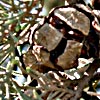Cypress is a tall and erect coniferous evergreen tree. It may reach a height of 25 meters. It is very common in boulevards, ornamental gardens, planted forests, cemeteries and as a windbreaker around plantations. Herzl’s cypress tree, which was planted by Herzl at Motza, is also a Funeral Cypress. Isolated remains indicate that the cypress grew wild in Israel. Wild cypress remains were found in the Galilee (Kziv Stream), on Mount Hermon, Gilead and Edom. In Crete there are wild cypress trees that are believed to be 450 years old, and in Israel there is a planted individual that is approximately 230 years old. It is difficult to assess its age by the annual xylem rings, because it may form several pseudo-rings within one year which do not encircle its trunk entirely.
The Hebrew name is biblical, although it is not certain that the bible referred to the same species.
In the wild form, the branches are horizontal and impart the tree with a conical (“Christmas tree”) shape. The cultivated variety, which was apparently isolated by the Romans during antiquity, has erect branches which are parallel to the trunk, and create a narrow sword-shaped, dense and erect structure. This form is called Funeral Cypress (Cupressus sempervirens var. pyramidalis).
The leaves are scaly, not needle-shaped, appressed to the branches. The cone (strobilus) is spherical, 3 cm in diameter. It lignifies and hardens upon maturation and its scales open for dispersal of the seeds.
The male cones are carried at the tips of the green branches. They are less than 5 mm in length and light brown in color. The pollen is plentiful, fills the air during dry days in spring. The pollen causes seasonal hay fever among people who are allergic to this species.
Written by Mike Livne







